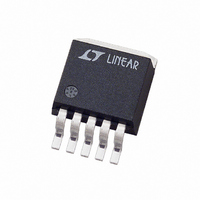LT1528CQ#PBF Linear Technology, LT1528CQ#PBF Datasheet - Page 9

LT1528CQ#PBF
Manufacturer Part Number
LT1528CQ#PBF
Description
IC LDO REG 3.3V/ADJ 3A DDPAK-5
Manufacturer
Linear Technology
Datasheet
1.LT1528CTPBF.pdf
(12 pages)
Specifications of LT1528CQ#PBF
Regulator Topology
Positive Fixed and Adjustable
Voltage - Output
3.3V, 3.3 ~ 14.15 V
Voltage - Input
3.9 ~ 15 V
Voltage - Dropout (typical)
0.57V @ 3A
Number Of Regulators
1
Current - Output
3A
Current - Limit (min)
3.2A
Operating Temperature
0°C ~ 125°C
Mounting Type
Surface Mount
Package / Case
TO-263-5, D²Pak (5 leads + Tab), TO-263BA
Lead Free Status / RoHS Status
Lead free / RoHS Compliant
Available stocks
Company
Part Number
Manufacturer
Quantity
Price
APPLICATIONS INFORMATION
The maximum junction temperature will be equal to the
maximum junction temperature rise above ambient plus
the maximum ambient temperature or:
Output Capacitance and Transient Performance
The LT1528 is designed to be stable with a wide range
of output capacitors. The minimum recommended value
is 3.3μF with an ESR of 2Ω or less. The LT1528 output
transient response will be a function of output capacitance.
See the Transient Response curves in the Typical Perfor-
mance Characteristics. Larger values of output capacitance
will decrease the peak deviations and provide improved
output transient response for larger load transients. By-
pass capacitors, used to decouple individual components
powered by the LT1528, will increase the effective value
of the output capacitor.
Microprocessor Applications
The LT1528 has been optimized for microprocessor ap-
plications, with the fastest transient response of current
PNP low dropout regulators. In order to deal with the
large load transients associated with current generation
microprocessors, output capacitance must be increased.
To meet worst-case voltage specifi cations for many
popular processors, four 47μF solid tantalum surface
mount capacitors are recommended for decoupling at
the microprocessor. These capacitors should have an
ESR of approximately 0.1Ω to 0.2Ω to minimize transient
response under worst-case load deltas. The Typical Ap-
plication shows connections needed to supply power for
Table 2. Fault Conditions
T
JMAX
< V
< V
– 15V < V
INPUT PIN
OUT
OUT
≤ 0.8V
≤ 0.8V
> 1.5V
Open
Open
= 50°C + 31.4°C = 81.4°C
(Nominal)
(Nominal)
IN
< 15V
Open (High)
Open (High)
Open (High)
Open (High)
SHDN PIN
Grounded
Grounded
Grounded
Grounded
Forced to V
Forced to V
OUTPUT/SENSE PINS
≤ 0V
≤ 0V
≤ 0V
≤ 0V
> 1V
> 1V
OUT
OUT
several different processors. This application allows the
output voltage to be jumper selectable.
Protection Features
The LT1528 incorporates several protection features, such
as current limiting and thermal limiting, in addition to the
normal protection features associated with monolithic
regulators. The device is protected against reverse input
voltages and reverse voltages from output to input.
Current limit protection and thermal overload protection
are intended to protect the device against overload con-
ditions. For normal operation the junction temperatures
should not exceed 125°C.
The input of the device will withstand reverse voltages
of 15V. Current fl ow into the device will be limited to less
than 1mA (typically less than 100μA) and no negative
voltage will appear at the output. The device will protect
both itself and the load.
The SENSE pin is internally clamped to one diode drop
below ground. If the SENSE pin is pulled below ground,
with the input open or grounded, current must be limited
to less than 5mA.
Several different input/output conditions can occur in
regulator circuits. The output voltage may be held up
while the input is either pulled to ground, pulled to some
intermediate voltage or is left open circuit. Current fl ow
back into the output will vary depending on the conditions.
Many circuits incorporate some form of power manage-
ment. The following information summarized in Table 2
will help optimize power usage.
(Nominal)
(Nominal)
RESULTING CONDITIONS
Reverse Output Current ≈ 150μA (See Figure 3)
Input Current ≈ 1μA (See Figure 4)
Reverse Output Current ≈ 150μA (See Figure 3)
Input Current ≈ 1μA (See Figure 4)
Reverse Output Current ≈ 150μA (See Figure 3)
Reverse Output Current ≈ 150μA (See Figure 3)
Output Current = 0
Output Current = 0
Output Current = Short-Circuit Current
Output Current = 0
LT1528
1528fb
9














